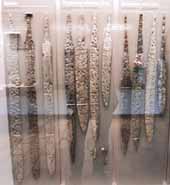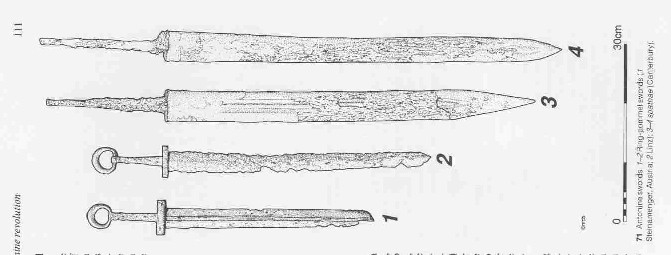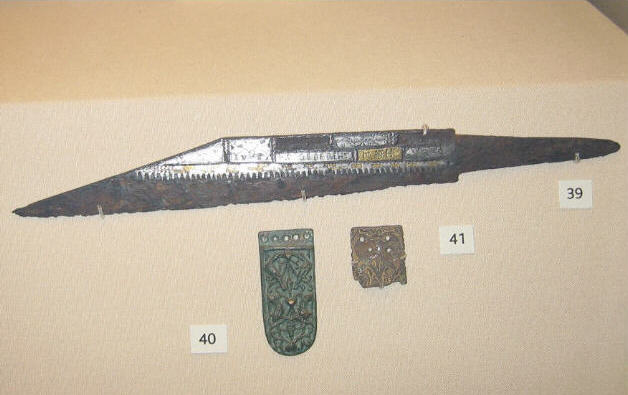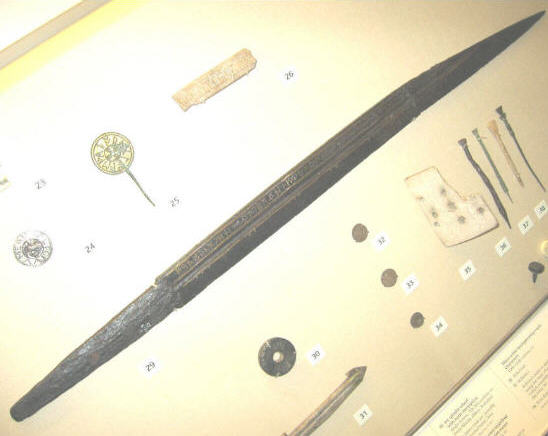| Author |
Message |
|
Joe Maccarrone
Location: Burien, WA USA Joined: 19 Sep 2003
Posts: 190
|
 Posted: Tue 13 Sep, 2005 3:00 am Post subject: Pics of two-handed seaxes? Posted: Tue 13 Sep, 2005 3:00 am Post subject: Pics of two-handed seaxes? |
 |
|
I've read in several places of the existence of seaxes with handles long enough for two hands; for example, Peter Johnsson posted these comments here on myArmoury a year or two ago, in the context of a very informative seax thread (I saved it all):
Bigger examples often have longer/stouter tangs (leaving room for two hands in some cases). The way these blades are fashioned makes me think of some kind of migration era wakisashi, only a bit stouter.
A long sax (langseax) is a long bladed weapon that usually has a knife style grip (as a norm with hidden tang and not riveted on slabs) The Long seax can have a long grip, perhaps 25 cm or sometimes even longer. These weapons will have a blade of some 55 cm up to proper sword-length blades. They still do not have sword style hilts however: they are typically mounted just like very big knives: a hidden tang of almost the same width as athe blade secured with pitch and sometimes a rivet at the protruding end.
There are naturally variations to this, but these should not be regarded as typical examples ot the classic seax.
I'm very intrigued by this. Does anyone have a picture of a long seax with such a tang? Peter, if you see this thread, do you have any photos or sketches?
Thanks!
|
|
  |
 |
|
Peter Johnsson
Industry Professional
|
 Posted: Tue 13 Sep, 2005 4:40 am Post subject: Posted: Tue 13 Sep, 2005 4:40 am Post subject: |
 |
|
Here are two really bad pics that might give you some idea...
The first pic shows a recostructed weapon by the german smith Manfred Sachse (the grandfather of modern european pattenrwelding). The original has a rather normal length tang, but I cannot say if it was broken or why a long grip was decided for in the reconstruction. Anyway, it gives a rather good idea of what they oould have looked like when new. Note patternwelding in the fuller region, while the main part of the blade is non-patterned carbon steel.
The second really bad one is from the city museum of Ingolstadt showing three double edged migration era spathas on the left for scale. Note that some of the seaxes have very long tangs. In two cases longer than the blade itself. The blades look small compared to the double edged swords, but they are much more massive in thickness. While a migration sword might be around 5 mm in thickness, these seaxes can be 8 mm in the back and have a much more massive cross section.
One seax have traces of the wooden grip intact just behind the blade.
Hope this helps.
 Attachment: 8.97 KB Attachment: 8.97 KB

 Attachment: 36.32 KB Attachment: 36.32 KB

|
|
   |
 |
Jean Thibodeau

|
 Posted: Tue 13 Sep, 2005 5:18 am Post subject: Posted: Tue 13 Sep, 2005 5:18 am Post subject: |
 |
|
Peter;
Just a question: Could some of these with very long tang have been mounted as polearms ? I'm sure that this would be physically possible but any hint anywere that it may have been done historically ?
Unless there is some design reason why not: Could one of these have been mounted originally as a knife and then after being passed from generation to generation , be remounted numerous times as either a polearm or as a knife.
In use these do distantly remind me of a Naginata and these were at times remounted as swords.
You can easily give up your freedom. You have to fight hard to get it back!
|
|
  |
 |
Elling Polden

|
 Posted: Tue 13 Sep, 2005 5:24 am Post subject: Posted: Tue 13 Sep, 2005 5:24 am Post subject: |
 |
|
I would guess the long handle is merely an attempt to balance the weapon better, in lieu of a pommel.
There are a number of scandinavian "hewing spears" mentioned in the sagas, but unfortunately, we dont know exactly what they looked like.
But all the scandinavian spears I have seen have a "socket mount", not a tang.
"this [fight] looks curious, almost like a game. See, they are looking around them before they fall, to find a dry spot to fall on, or they are falling on their shields. Can you see blood on their cloths and weapons? No. This must be trickery."
-Reidar Sendeman, from King Sverre's Saga, 1201
|
|
    |
 |
Jean Thibodeau

|
 Posted: Tue 13 Sep, 2005 5:42 am Post subject: Posted: Tue 13 Sep, 2005 5:42 am Post subject: |
 |
|
Elling;
Yes the thought of hewing spears did cross my mind as a remote possibility.
I just think it can be usefull to sometimes ask a question even if the answer is probably already known to be in the negative: Sort of in the spirit of " has anybody ever considered this as a possibility " and it might bring forward other and better ideas.
Thank for your view that is probably 99.99% true. 
You can easily give up your freedom. You have to fight hard to get it back!
|
|
  |
 |
Craig Peters

|
 Posted: Tue 13 Sep, 2005 7:31 am Post subject: Posted: Tue 13 Sep, 2005 7:31 am Post subject: |
 |
|
| Peter Johnsson wrote: | Here are two really bad pics that might give you some idea...
The first pic shows a recostructed weapon by the german smith Manfred Sachse (the grandfather of modern european pattenrwelding). The original has a rather normal length tang, but I cannot say if it was broken or why a long grip was decided for in the reconstruction. Anyway, it gives a rather good idea of what they oould have looked like when new. Note patternwelding in the fuller region, while the main part of the blade is non-patterned carbon steel.
The second really bad one is from the city museum of Ingolstadt showing three double edged migration era spathas on the left for scale. Note that some of the seaxes have very long tangs. In two cases longer than the blade itself. The blades look small compared to the double edged swords, but they are much more massive in thickness. While a migration sword might be around 5 mm in thickness, these seaxes can be 8 mm in the back and have a much more massive cross section.
One seax have traces of the wooden grip intact just behind the blade.
Hope this helps. |
You know, a regular seaxe and a longer two handed seaxe would make excellent additions to the Next Generation line... 
|
|
  |
 |
|
J. Padgett
Location: In a comfy chair Joined: 17 Nov 2003
Posts: 137
|
 Posted: Tue 13 Sep, 2005 8:07 am Post subject: Posted: Tue 13 Sep, 2005 8:07 am Post subject: |
 |
|
| Craig Peters wrote: | You know, a regular seaxe and a longer two handed seaxe would make excellent additions to the Next Generation line...  |
I'll second that. 
"The truth shall make ye fret."
|
|
  |
 |
|
Johan S. Moen
Location: Kristiansand, Norway Joined: 26 Jan 2004
Posts: 259
|
 Posted: Tue 13 Sep, 2005 9:03 am Post subject: Posted: Tue 13 Sep, 2005 9:03 am Post subject: |
 |
|
Two-handed seax; weird dacian falx(or the other way around...). Just crossed my mind...
Johan Schubert Moen
|
|
  |
 |
Sean Flynt

|
|
   |
 |
|
Joe Maccarrone
Location: Burien, WA USA Joined: 19 Sep 2003
Posts: 190
|
 Posted: Tue 13 Sep, 2005 4:36 pm Post subject: Posted: Tue 13 Sep, 2005 4:36 pm Post subject: |
 |
|
Thank you, Peter! Those pictures give me a perfect idea.. 
Very interesting weapon. I can imagine how it might have been wielded...
|
|
  |
 |
Elling Polden

|
 Posted: Fri 16 Sep, 2005 8:35 am Post subject: Posted: Fri 16 Sep, 2005 8:35 am Post subject: |
 |
|
| Joe Maccarrone wrote: | | Very interesting weapon. I can imagine how it might have been wielded... |
Ah? I must admit I can't see it as anything but a better balanced sax
"this [fight] looks curious, almost like a game. See, they are looking around them before they fall, to find a dry spot to fall on, or they are falling on their shields. Can you see blood on their cloths and weapons? No. This must be trickery."
-Reidar Sendeman, from King Sverre's Saga, 1201
|
|
    |
 |
|
Felix Wang
|
 Posted: Fri 16 Sep, 2005 1:39 pm Post subject: Posted: Fri 16 Sep, 2005 1:39 pm Post subject: |
 |
|
| Johan S. Moen wrote: | Two-handed seax; weird dacian falx(or the other way around...). Just crossed my mind...
Johan Schubert Moen |
There is an interesting reference in Tacitus, which I previously posted in SwordForum, hints at earlier two-handed sword usage:
"S. Perevalov's article "The Sarmatian Lance and the Sarmatian Horse-riding Posture", from Anthropology & Archeology of Eurasia, vol. 41 no. 4 (Spring of '02). In the discussion, he cites Tacitus (Hist. I, 79) about long lances and long swords.
"sed tum umido die et soluto gelu neque conti neque gladii, quos praelongos utraque manu regunt, usui, lapsantibus equis et catafractum pondere."
A translation of G. S. Knabe follows.
"On the day when it was raining, the ice was melting, and the Sarmatians could not use either their lances or their very long swords, which they hold with two hands; their horses were sliding in the mud, and the heavy coats of mails (sic) were impeding their fighting ability." (my italics)
The discussion then goes on to an analysis of Tacitus' writing style, and whether the lances were used with two hands.
Of course, there is no comment at all on the swords which were very long and used with both hands!
Now, the Sarmatians and similar cataphracts were frequently shown holding lances in both hands, and without a shield. This would conceivably allow two-handed sword usage, on or off a horse."
Possibly related to this is a speciman from Bishop and Coulston's Roman Military Equipment, which shows some spatha-like swords with excessively long tangs - about 8 inches or so. Such a long tang suggests a rather long grip.
 Attachment: 37.52 KB Attachment: 37.52 KB

|
|
  |
 |
David McElrea

|
 Posted: Sat 17 Sep, 2005 4:53 pm Post subject: Posted: Sat 17 Sep, 2005 4:53 pm Post subject: |
 |
|
I'll use this thread as an excuse to post a couple of more pics from the British Museum. The first seax is obviously the standard one-handed. The second... I cannot tell, for the life of me. In the photo the hilt looks quite long (in comparison with the other), but it's hard to say.
Both are stunners either way.
David
 Attachment: 34.83 KB Attachment: 34.83 KB

 Attachment: 27.93 KB Attachment: 27.93 KB

|
|
  |
 |
|
Peter Johnsson
Industry Professional
|
 Posted: Sun 18 Sep, 2005 12:31 am Post subject: Posted: Sun 18 Sep, 2005 12:31 am Post subject: |
 |
|
| David McElrea wrote: | I'll use this thread as an excuse to post a couple of more pics from the British Museum. The first seax is obviously the standard one-handed. The second... I cannot tell, for the life of me. In the photo the hilt looks quite long (in comparison with the other), but it's hard to say.
Both are stunners either way.
David |
Yes!
The bottom one, the Battersea seax, is a good example of those weapons with longer grips. This one doeas not have such a log grip as some of the Germanic examples, but it is at least of some hand-and-a-half length...
You can also tell a great difference in intended funcions between these two blades, the top one is more of a big hunting knife that can double as a personal defence weapon, while the Battersea seax is exclusively a weapon of sword size: good for both cutting and thrusting.
|
|
   |
 |
|
|

